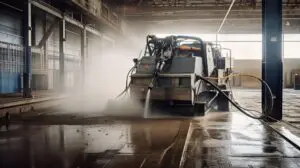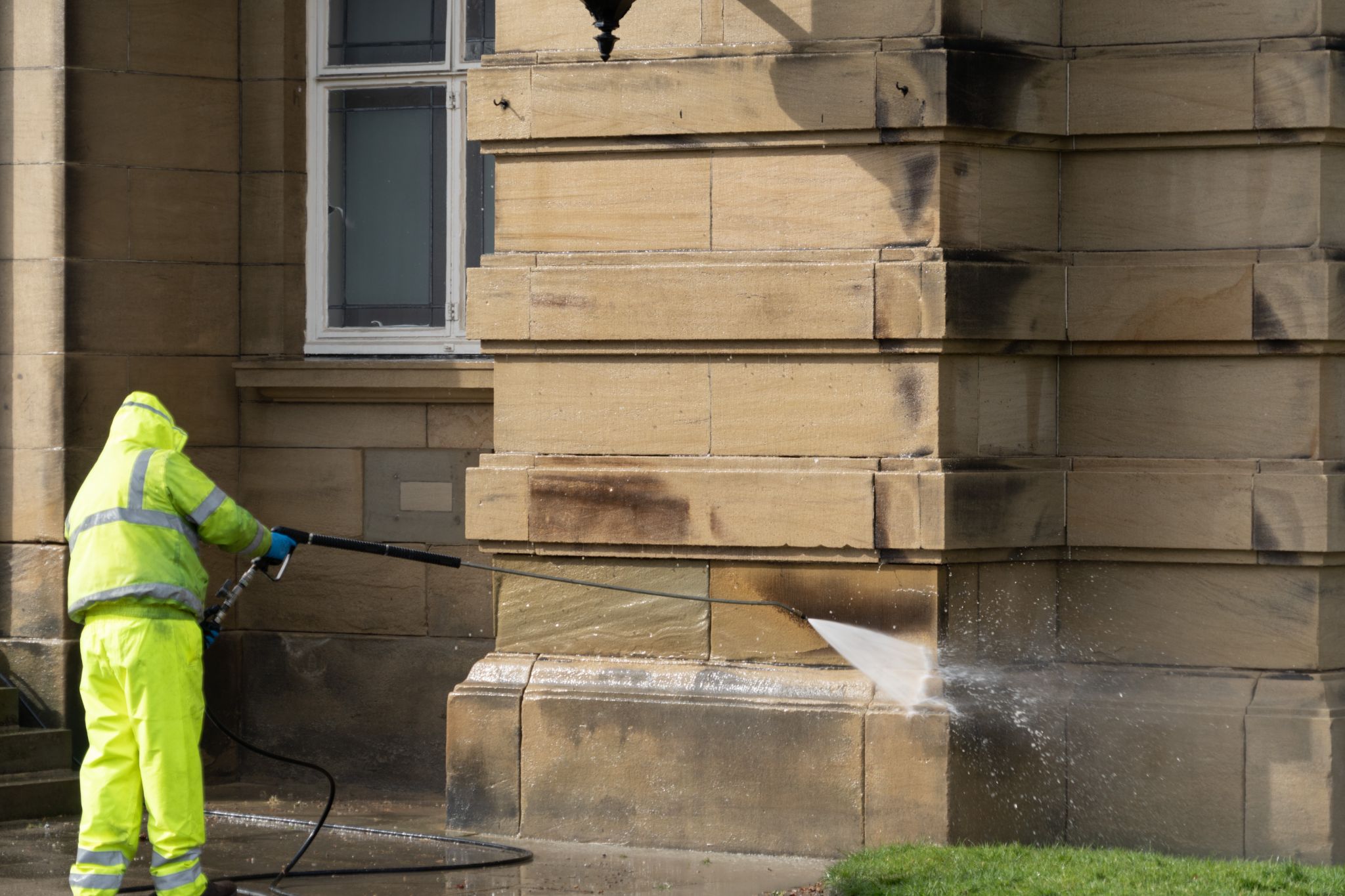If you’re not new to industrial cleaning, you’ve probably heard of hydroblasting. But what is hydroblasting really and is it more environmentally friendly than other forms of industrial cleaning?
The following overview will walk you through how hydroblasting works, the different types of hydroblasting procedures, and the benefits of hydroblasting over other industrial cleaning methods. Let’s delve in!
What is Hydroblasting?
Hydroblasting, also known as high-pressure water jetting, is a non-abrasive industrial cleaning technique that utilizes specialized equipment to direct high-pressure streams of water to clean, cut, or remove surface contaminants and materials.
Hydroblasting can also be called pressure washing or hydrocleaning.
Hydroblasting equipment can blast anywhere from 10,000 to 40,000 psi (pounds per square inch) of water pressure onto surfaces to remove paint, rust, and other surface contaminants.
Unlike water blasting, which uses lower water pressure (usually less than 10,000 psi) to clean dirt, grime, and rust, hydroblasting uses extreme water pressure to clean and prepare various industrial projects.
Hydroblasting in Industrial and Commercial Settings
Hydroblasting is commonly used in industrial settings because industries that create and operate objects on a large scale produce extreme levels of grime, dirt, and wear and tear.
It is a preferred industrial cleaning method by many industries because of its cleaning efficiency, non-abrasive methodology, versatility, and environmental friendliness.
While hydroblasting can be applied creatively in ways that fit every industry, the most common uses of hydroblasting in the industrial setting include surface preparation, pipe and tube cleaning, equipment and machinery maintenance, tank and vessel cleaning, concrete and structural demolition, and marine industry needs.
The following are some of the most common uses of hydroblasting in various industries:
- Clearing blockages from industrial piping systems
- Removing grease, oil, and sludge from production processes
- Precision cutting and material removal
- Removing deposits from heat exchanger tubes and systems
- Cleaning the interior surfaces of storage tanks
- Cutting and demolishing concrete structures
- Preparing surfaces for paint recoating
- Removing marine growth from ships and boats
- Helps maintain marine structures from structural damage
- Cleaning up of hazardous materials and chemical residues
The Benefits of Hydroblasting Over Other Cleaning Methods
There are many benefits to choosing hydroblasting over other cleaning methods, one of the most important reasons being its environmental friendliness.
Waterblasting only uses water in its cleaning process, which negates the use of any harsh chemicals that could endanger workers and become an environmental hazard. Water is also a preferable cleaning method for dust suppression, helping to lower the levels of dust generated in the cleaning process.
Efficiency and adaptability are also big benefits of hydroblasting over other cleaning methods. Hydroblasting uses extreme pressure that can be adjusted due to the needs of a particular project. This versatility ensures that the cleaning doesn’t cause damage to the surface.
Yet another reason to choose industrial hydroblasting over other cleaning methods is that hydroblasting is a faster option than other more abrasive and low-pressure cleaning options. It reduces the time needed for maintenance and can be used in multiple ways to keep operations running smoothly.
How Hydroblasting Works
Now that you’re more familiar with what hydroblasting is, let’s look at how hydroblasting works!
Here are the direct steps of the process that you can expect:
- Hydroblasting equipment is brought to the cleaning area and is hooked to a water source, a hose, and a high-pressure pump.
- The equipment operator ensures safety by wearing protective equipment, such as a suit, helmet, gloves, and boots.
- The operator then adjusts the pressure depending on the task at hand and uses specialized nozzles to control the flow and direction of the water.
- Once the cleaning is complete, the cleaning areas are checked for any extra maintenance needs.
- The equipment is finally shut off and inspected for any wear and tear or leakage.

When is Hydroblasting Needed?
Hydroblasting is not only needed for standard cleaning needs but is ideal for emergencies and maintenance and upkeep.
High-risk blockages in pipelines and sewages can pose emergencies. This is precisely when hydroblasting can come to the rescue! The process can quickly and efficiently remove the blockage to prevent damage and lower damage upkeep.
Another scenario that requires hydroblasting as an intervention is upkeep and maintenance. Regular maintenance and cleaning not only help retain the integrity of surfaces and machinery but also improve the efficiency of production.
Regular maintenance can help businesses offset long-term costs associated with production downtime, non-compliance fees, and inefficient operations.
Types of Hydroblasting
There are various types of hydroblasting options available for industries depending on their needs. Here are some of the most sought-after types and their applications.
Low-Pressure Hydroblasting
Low-pressure hydroblasting, or pressure washing, is characterized by pressure ranges of up to 5000 psi and is used most widely for cleaning and maintenance. The best use of low-pressure hydroblasting is for washing vehicles and buildings and removing light dirt and algae from surfaces.
High-Pressure Hydroblasting
High-pressure hydroblasting uses a pressure range of 5,000 to 10,000 psi to remove tough grime and grease and to prepare surfaces for painting and coating.
Ultra High-Pressure Hydroblasting
Ultra-pressure hydroblasting uses pressures between 10,000 and 40,000 psi to remove heavy rust deposits, and tough concrete, and to accomplish precision tasks like removing coatings without damage to the surface.
Sewer Jetting
Sewer jetting is a type of hydroblasting used to clear sewer blockages and allow for better-functioning sewer systems. It uses psi of 2,000 to 4,000 for residential purposes and 10,000 for industrial applications.
Abrasive Water Jetting
Abrasive water jetting is very similar to water jet cutting and often uses pressures of 20,000 to 60,000 psi to cut through hard substances in metalworking, stone cutting, and industrial demolition. This form of cutting can be more precise than the more standard cutting methods.
Safety Considerations
What is hydroblasting without safety? Every industrial cleaning measure is as successful as its safety protocols, and having a skilled professional handle the job is of utmost importance.
The Occupational Safety and Health Administration has issued OSHA hydroblasting regulations to govern the safety procedures of hydroblasting projects, and most hydroblasting companies abide by them.
When it comes to hydroblasting safety considerations, the use of appropriate protective gear such as protective clothing, face shields, gloves, and boots is essential to prevent hydroblasting injuries.
Next, equipment safety protocols such as regular inspections of the nozzles, hoses, and connections will help prevent accidents and negate worker injury.
Having an emergency protocol such as instituting an accessible emergency shutoff mechanism that quickly stops water flow is recommended, especially in ultra-high-pressure and abrasive water jetting procedures.
Overall, proper training and communication can help hydroblasting procedures go seamlessly. If hiring for hydroblasting services, always look for credible professionals with hydroblasting experience whom you can trust to accomplish your goals without complications.
Hydroblasting Services
Hydroblasting is a cost-efficient, environmentally friendly, and highly effective method for cleaning and preparing surfaces in the industrial setting. Most hydroblasting companies offer a variety of services with highly trained operators, but we recommend you choose the one that has experience working in your industry and project needs.
At Environmental Remedies, we use cutting-edge hydroblasting equipment and offer pressure-washing services for industrial facilities, warehouses, mobile fleets, heavy equipment, and other projects.
We also offer hydroblasting services for deeper cleaning needs with a water pressure of 15,000 psi.
To get started with your cleaning needs, request a quote for your hydroblasting project, and let us show you how seamless cleaning can be!






